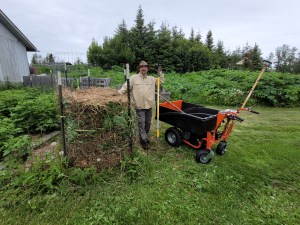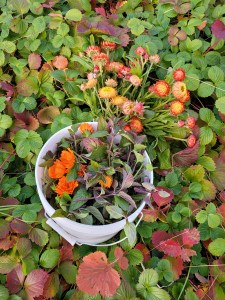If you were to come visit us right now, you might feel a little overwhelmed by the nature of our house. Quite literally, we’ve brought nature inside. In our entryway we’ve got a good sized chrysanthemum plant that we’re going to try to winter over in case the ones we planted outside don’t make it. In our living space there’s a crock of sauerkraut burping away and four baskets of mint and marjoram waiting for a turn in the food dehydrator in the next room over. Near our wood stove we’ve got a good haul of onions draped over a clothes drying rack before we put them into deeper storage, and in our pantry we’ve got about a hundred garlic bulbs curing. I hate to admit it, but I’m kind of glad our potato harvest wasn’t terribly impressive this year.
As I was digging our few potatoes last weekend I witnessed something I’d never seen before, which was an earthworm producing an egg sac. What caught my attention about this particular worm was the white ring around its mid-section. It looked as though it had slithered into a small plastic ring or bead, and I watched the worm work to push the ring off its body, going long and skinny and then short and plump until eventually a little pale orb fell off of its body into the dirt. I’ve since learned that the ring was picking up sperm off of the worm’s body as it squirmed it off of itself, and once the sac was deposited onto the soil it contained scores of fertilized eggs. It was something to behold.
Peeking into the soil and seeing a healthy bunch of earthworms wriggling around is deeply satisfying but I’d never given much thought to earthworm reproduction. Anything I might have learned about them in my high school biology class had long since left my brain, so I took a short dive down that wormhole by reading the fifth chapter of Secrets of the Soil, a book about biodynamic agriculture by Peter Tompkins and Christopher Bird.
The chapter was packed with facts about earthworms and historical anecdotes. Turns out Cleopatra understood the Egyptian valley’s fertility depended upon earthworms and she decreed that they be revered and protected as a sacred animal. Aristotle called them the “Guts of the Soil” and Charles Darwin considered the earthworm to be the “greatest plowman, an animal of greater value than the horse, relatively more powerful than the African elephant, and more important to man than even the cow.”
And did you know that earthworms excrete a kind of mucus that helps them wriggle through hard ground, and that same mucus acts to cement the walls of their pathways, which in turn creates soil structure that’s perfect for retaining water and making space for the roots of plants? Or that earthworms have a gizzard that allows them to digest both organic matter and raw earth, and what comes out as worm castings on the other end is nearly perfect humus that’s loaded with microbes, giving plants what they need structurally, nutritionally and with the right pH?
These powerful, unassuming creatures go about their lives creating the fertile ground that allows us to grow gardens and feed ourselves. They mix organic matter and minerals around and up and down, gradually deepening the topsoil layer and distributing nutrients to where plant roots can reach them. In fact one earthworm can produce its weight in castings each day and can move a stone that’s fifty times its weight. What this means is that if the earthworm population is happy, no rototiller is needed. And that is why when I finished digging potatoes last weekend I covered the ground with grass clippings, nettle, dandelion leaves, comfrey and a bunch of beet greens and cabbage leaves. Then I added a layer of meadow straw that Dean had the foresight to rake and set aside back in May, before everything greened up, knowing that we’d need it now when it’s time to tuck our garden and our soil and all those hungry earthworms in for the winter.
This year’s garden is just about wrapped up. The garlic has been planted and all that’s left in the ground are carrots, parsnips and some kale. Over the next few weekends we’ll get the rest of the beds put away for winter. We’ll add a little compost and a layer of green. We’ll cover them all up with leaves and straw, and then we’ll walk away. In our absence, the earthworms and their microbial cohort will be mixing and churning. When the ground freezes they’ll go down deep. When it starts to thaw they’ll move up again toward the surface, and they’ll bring some of that deep earth goodness with them. In the spring when we peel that layer of straw off the garden bed we’ll find that somehow, even in the cold, the earthworms will have done what earthworms are meant to do and the soil will be ready for the seeds and the plants that will eventually grow into the food that feeds us. No matter how many times I see it or how many gardens I tend, I’ll never stop marveling over the way of it all.
I find that it’s easier to write about the changing seasons and growing a garden than it is to write about God. And I don’t mean God as a bearded fellow ruling the universe, I mean God as The Way Things Work. I mean God as the continuous cycle of death and renewal. I mean God as the all-encompassing glue that makes everything touch everything else. I mean God as that nameless energy that keeps the world spinning and the oceans churning and the earthworms tilling up the ground so that we can grow snap peas and sweet carrots and potatoes and the like. It’s much easier to stick to the facts but I can’t stop thinking about how within the workings of the natural world there’s something supernatural going on. Something so simple, so perfect, so sustainable. Something so honest, so straightforward, so real.
I don’t claim to understand how it all works, or why. I just know that in a world where it’s easy to be distracted by billionaires and politicians and the near-constant barrage of information and opinion, there is something bigger that is worthy of our attention, and that there is nothing to lose and everything to gain by reorienting our existence toward whatever that bigger thing is. To do so we might put our hands in the dirt and our feet on the ground. We might turn off the lights and look up at the night sky. We might notice how we change as the seasons change. We might learn the ways of plants and animals and fungi and each other. With practice we might remember the truth of who we really are.
And who are we, really? We’re humans with physical, temporary bodies that require nourishment and clean air and pure water. We have big brains that allow us to learn from the past and imagine the future. We’re as natural as the earthworms that are digging and tilling away in my garden and yet we have this incredible capacity to give and receive love. Where did that come from, I wonder. And how can we put it to use? There must be 8.1 billion different ways.
***

*** If you’d like to join me for a ten day journaling practice starting on Nov. 1, please send me an email at tsundmark@protonmail.com. Every day for ten days I’ll send out a few journal prompts that will get you started, and then you’ll take it from there. It’s free to join and I’d love to have your company. I promise I won’t share your email with anyone else. Feel free to share with anyone else who might be interested and let me know if you have any questions. — Teresa




Teresa, this is a wonderful piece of writing. I love love love it. Thank you!!
You’re welcome! Thanks for reading it. 🙂